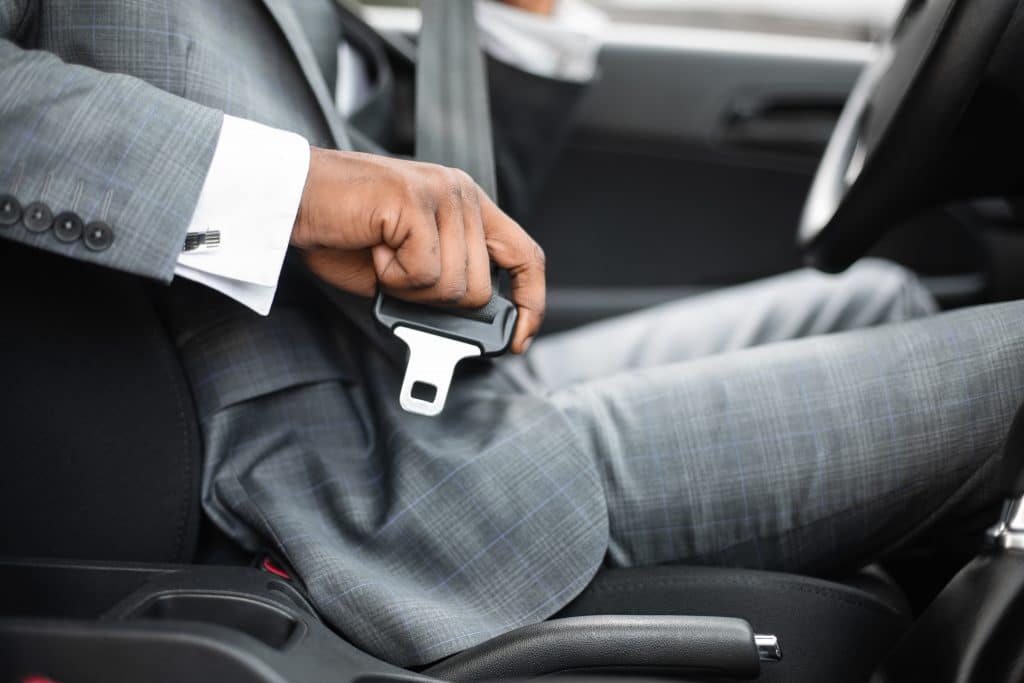Wearing a seat belt when you drive is a legal requirement in almost every U.S. state. And in over 50% of the US, passengers must also be wearing seat belts. No matter your state’s requirements, the threat of a car accident should be enough to ensure you repair a seat belt buckle as soon as possible.
Riding in a car seat without a seat belt is extremely dangerous, no matter the circumstances. Luckily, fixing a broken seat belt buckle is easy if you follow the right steps and may require no additional parts. If you’re having seat belt issues and want to know the best methods to fix a seat belt buckle in almost any car, keep reading for our ultimate guide on how to fix a seat belt buckle!
How Do Seat Belt Buckles Work?
Seat belt buckles work by locking the mechanism’s tongue or seatbelt retractor (otherwise known as the male part) into the buckle (female part). The tongue pushes past a small spring tab and compresses the springs inside of the buckle. Once the tongue has fully compressed the springs, the spring tab rises back up in the gap in the middle of the tongue, locking it into position. When the release button is pressed, the tab is compressed again. Since nothing is holding the tongue into place, it rises and releases from the buckle.
Sometimes, the seat belt buckle mechanism can stop working. The tab can get stuck and fail to rise and lock the tongue into position, preventing you from buckling up. Sometimes, the springs can become jammed and refuse to compress when the tongue is pressed against them. In other cases, if the release button is jammed, you might be prevented from unbuckling. If you have any issues preventing you from using your seatbelt, you should address them as soon as possible.
5 Essential Steps to Fix a Seat Belt Buckle
Clean the Tongue of the Seat Belt Buckle
Before taking any other steps to fix your seatbelt buckle, you should clean the seat belt tongue to ensure that caked-up grime isn’t preventing it from going inside the buckle. You can usually scrape debris off by hand, but if any substances on the tongue are giving you extra trouble, warm and soapy water or cleaners generally work to dissolve any sticky or hardened grime.
Repair the Buckle of the Seat Belt Buckle With No Disassembly
If your seatbelt buckle still isn’t working despite cleaning the tongue, it’s time to start cleaning the buckle itself. Removing the buckle and cleaning the internal mechanism can be a hassle, though, so it’s worth starting with a few easy no-disassembly methods to see if they resolve your buckling problem. You can begin by using a thin tool like a butter knife to dislodge any debris before spraying compressed air inside to clear it out. You can also apply WD-40 inside the buckle to see if it helps the tongue slide inside.
Remove and Disassemble the Buckle of the Seat Belt Buckle
If you find that your seatbelt buckle still isn’t working after cleaning the buckle and tongue, you can attempt to fix the seat belt buckle by removing the buckle and giving it a deep clean. Depending on your vehicle model and where the buckle is located, this may be as simple as unscrewing the buckle and as complicated as removing the seat — you can check for instructions in your vehicle’s owner’s manual.
You should take the seat belt buckle to your preferred workspace and remove all the visible screws from the edges of the buckle. Once completely unscrewed, you can pry the buckle open using a thin tool like a flathead screwdriver, slowly and carefully to avoid breaking it accidentally. Once the buckle is open, you can check that all internal components function.
The spring tab in the middle of the seat belt buckle should compress when you press on it and immediately rise when released. The springs at the bottom of the buckle should compress when pushed on, and pressing the release button should cause a small wedge at the bottom to push forward. If you notice that debris is blocking the function of any of the components, you should use small pliers or compressed air to remove it. You can also apply WD-40 as needed.
Fix a Stuck Seat Belt Buckle That Won’t Release
While it’s common to encounter seat belt buckles that won’t lock, drivers sometimes encounter the opposite issue — their seat belt suddenly won’t release anymore. And if someone is being held inside the vehicle by the faulty buckle, it can quickly become an urgent issue. Luckily, it’s just as simple to fix a jammed seat belt buckle that won’t release as long as you have the right tools.
Most of the time, you can use small tools like a thin screwdriver or a butter knife to attempt to dislodge anything jamming the seat belt. You can also try to apply WD-40 or spray compressed air inside the opening. If these methods don’t work, you can unscrew the buckle from the vehicle to release the passenger before opening it to unlock the mechanism inside manually. Once the tongue is released, you can examine the buckle’s internal mechanisms to repair and clean it as needed.
Ensure That Your Seat Belt Works Properly
It’s essential to make sure your seat belt is working correctly once you’ve fixed it. Seat belts protect you, and a minor fender bender could quickly turn into a catastrophic injury if they’re not functional during an accident. In fact, out of the nearly 50,000 vehicular accident fatalities that occurred in the United States in 2021, it’s estimated that over half of the deaths could have been prevented with proper seat belt usage.
The webbing of your seat belts should have no tears or visible weaknesses. You should sit with your back and hips fully against the seat and allow the shoulder strap to remain taut over your shoulder and collarbone, across your torso, and towards the buckle at your hip. This will ensure you don’t fly forwards during an accident. The lower belt should be positioned low on your hips and remain taut as you drive since it will prevent you from slipping under the belt during an accident.
Final Thoughts: Fixing a Seat Belt Buckle
Unfortunately, a broken seat belt buckle can be a big issue — especially if it’s in the driver’s seat. Being able to buckle up is a safety essential, not to mention a legal requirement, so you’ll need to address a broken seat belt buckle as soon as possible.
In most cases, fixing a broken seat belt buckle is as simple as cleaning the buckle’s internal mechanisms and the tongue. If it doesn’t seem to fix your vehicle, you may need to seek the help of an experienced auto repair technician or attempt to replace the seat belt buckle yourself. As long as you apply yourself, you’ll quickly find your broken seat belt buckle issue resolved in no time.




